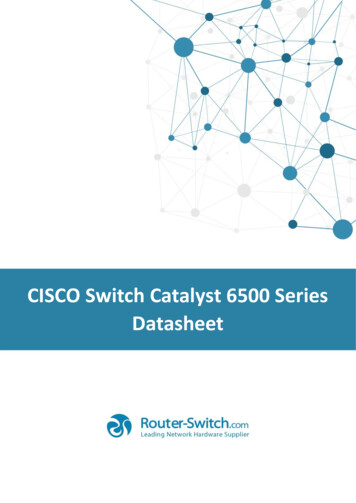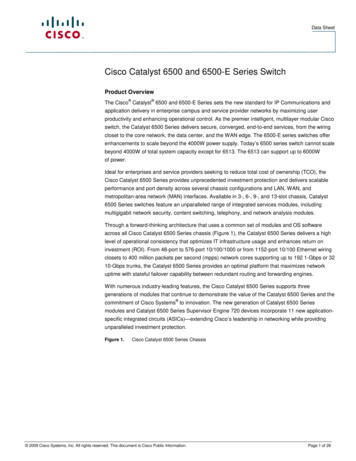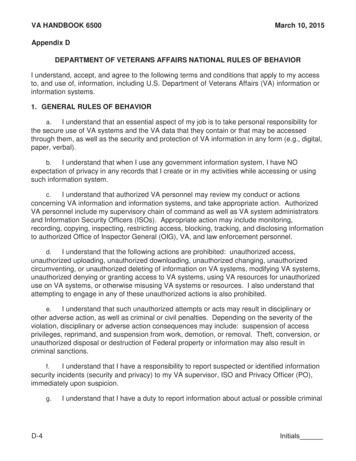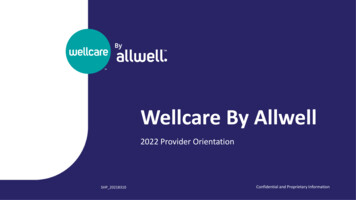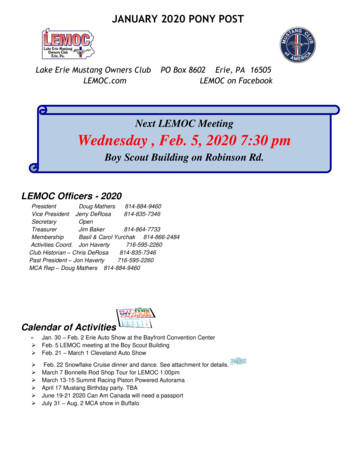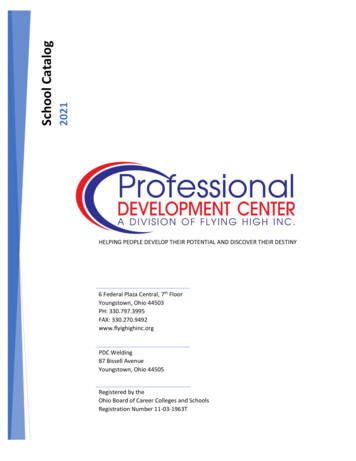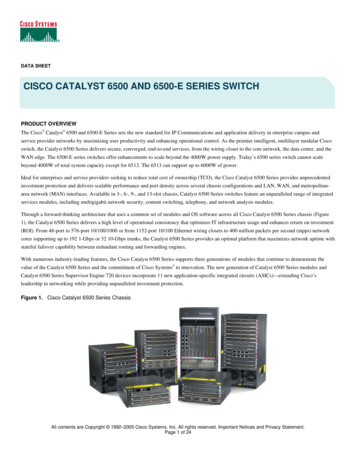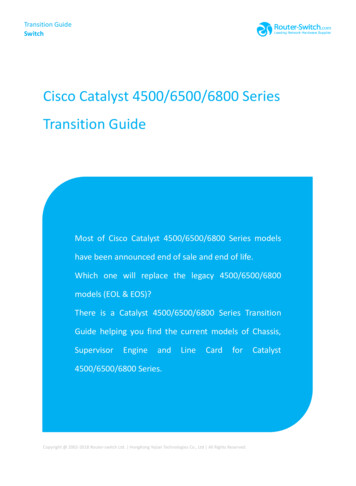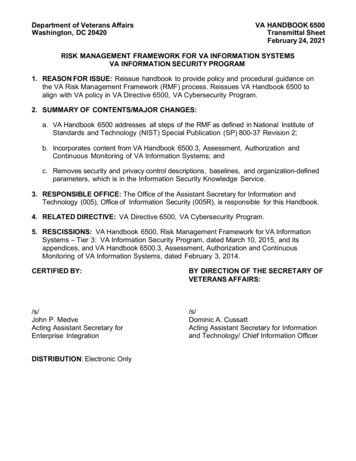
Transcription
Department of Veterans AffairsWashington, DC 20420VA HANDBOOK 6500Transmittal SheetFebruary 24, 2021RISK MANAGEMENT FRAMEWORK FOR VA INFORMATION SYSTEMSVA INFORMATION SECURITY PROGRAM1. REASON FOR ISSUE: Reissue handbook to provide policy and procedural guidance onthe VA Risk Management Framework (RMF) process. Reissues VA Handbook 6500 toalign with VA policy in VA Directive 6500, VA Cybersecurity Program.2. SUMMARY OF CONTENTS/MAJOR CHANGES:a. VA Handbook 6500 addresses all steps of the RMF as defined in National Institute ofStandards and Technology (NIST) Special Publication (SP) 800-37 Revision 2;b. Incorporates content from VA Handbook 6500.3, Assessment, Authorization andContinuous Monitoring of VA Information Systems; andc. Removes security and privacy control descriptions, baselines, and organization-definedparameters, which is in the Information Security Knowledge Service.3. RESPONSIBLE OFFICE: The Office of the Assistant Secretary for Information andTechnology (005), Office of Information Security (005R), is responsible for this Handbook.4. RELATED DIRECTIVE: VA Directive 6500, VA Cybersecurity Program.5. RESCISSIONS: VA Handbook 6500, Risk Management Framework for VA InformationSystems – Tier 3: VA Information Security Program, dated March 10, 2015, and itsappendices, and VA Handbook 6500.3, Assessment, Authorization and ContinuousMonitoring of VA Information Systems, dated February 3, 2014.CERTIFIED BY:BY DIRECTION OF THE SECRETARY OFVETERANS AFFAIRS:/s/John P. MedveActing Assistant Secretary forEnterprise Integration/s/Dominic A. CussattActing Assistant Secretary for Informationand Technology/ Chief Information OfficerDISTRIBUTION: Electronic Only
VA Handbook 6500February 24, 2021RISK MANAGEMENT FRAMEWORK FOR VA INFORMATION SYSTEMSVA INFORMATION SECURITY PROGRAMCONTENTSPARAGRAPHPAGE1.PURPOSE. . 62.SCOPE. . 63.BACKGROUND/OVERVIEW. 74.RESPONSIBILITIES . 5)(16)(17)(18)(19)(20)(21)Assistant Secretary for Information and Technology/ . 9Office of Information Technology (OIT) Deputy Assistant Secretary for InformationSecurity. 10Executive Director for Office of Acquisitions, Logistics, and Construction . 11OIT Deputy Assistant Secretary for Development,Security and Operations (DASDevSecOps), . 11OIT Associate Deputy Assistant Secretary for Enterprise Program ManagementOffice . 11OIT Associate Deputy Assistant Secretary for Information Technology Operationsand Services (ADAS ITOPS) . 11Under Secretaries, Assistant Secretaries and Other Key Officials . 12Senior Agency Official for Privacy (SAOP) . 12VA Enterprise Architect shall . 12Risk Management Framework Technical Advisory Group (RMF TAG) shall . 12Information System Security Officer (ISSO) . 13Information System Security Manager . 16Authorizing Officials (AOs) . 17Authorizing Official Designated Representative . 17Information System Owner . 17Chief Privacy Officer . 19Privacy Officer . 19Information System Security Engineer . 19Security Control Assessors . 19Information Security Architect . 20Risk Executive Function . 203
VA Handbook 6500February 24, 2021RISK MANAGEMENT FRAMEWORK FOR VA INFORMATION SYSTEMSVA INFORMATION SECURITY PROGRAMCONTENTS, cont.PARAGRAPHPAGE5. RISK MANAGEMENT OF INFORMATION TECHNOLOGY PRODUCTS, SERVICES,AND PLATFORM INFORMATION TECHNOLOGY. 96.PROCEDURES . 23(1)(2)(3)(4)(5)(6)(7)PREPARE. 23CATEGORIZE SYSTEM . 25SELECT SECURITY CONTROLS. . 26IMPLEMENT SECURITY CONTROLS. . 32ASSESS SECURITY CONTROLS. . 34AUTHORIZE SYSTEM. 37CONTINUOUS MONITORING . 464
VA Handbook 6500February 24, 2021RISK MANAGEMENT FRAMEWORK FOR VA INFORMATION SYSTEMSVA INFORMATION SECURITY PROGRAMCONTENTS, cont.APPENDICESPAGEAPPENDIX A. Terms and Definitions . A-1APPENDIX B. Acronyms and Abbreviations . B-1APPENDIX C. References .C-1APPENDIX D. High-Level Summary of RMF Tasks.D-1Table 1: Prepare Tasks—Organization Level .D-1Table 2: Prepare Tasks—System Level.D-4Table 3: Categorize Tasks .D-10Table 4: Select Tasks and Outcomes .D-12Table 5: Implement Tasks and Outcomes .D-16Table 6: Assess Tasks and Outcomes.D-17Table 7: Authorize Tasks and Outcomes .D-20Table 8: Monitor Tasks and Outcomes .D-23FIGURESPAGEFigure 1: VA IT Resources . 8Figure 2: VA Risk Management Framework Steps . 8TABLESPAGETable 1: Appointment of RMF Roles . 95
VA Handbook 6500February 24, 2021RISK MANAGEMENT FRAMEWORK FOR VA INFORMATION SYSTEMSVA INFORMATION SECURITY PROGRAM1. PURPOSE.a. Updates VA Handbook 6500 to align with VA policy in VA Directive 6500, VACybersecurity Program;b. Establishes associated cybersecurity policy and assigns responsibilities for executingand maintaining the Risk Management Framework (RMF);c. Directs visibility of authorization documentation and reuse of artifacts between andamong VA Information Technology (IT) stakeholders; andd. Provides procedural guidance for the reciprocal acceptance of authorization decisionsand artifacts within VA and between VA and other Federal agencies, for theauthorization and connection of information systems.2. SCOPE.a. The VA Handbook 6500 satisfies the Federal and statutorily requirements of:(1) Federal Information Security Modernization Act (FISMA);(2) U.S. Code (U.S.C) title 38, Veterans’ Benefits Act, Subchapter III - InformationSecurity;(3) National Institute of Standards and Technology (NIST) Special Publication (SP) 80037, Risk Management Framework for Information Systems and Organizations, ASystem Life Cycle Approach for Security and Privacy;(4) Office of Management and Budget (OMB) Circular A-130;(5) The Privacy Act of 1974;(6) Health Insurance Portability and Accountability Act of 1996 (HIPAA); and(7) The Health Information Technology for Economic and Clinical Health (HITECH) Act.b. This handbook serves all Administrations, Staff Offices, Staff Organizations, Boards,and Special Programs of the Department of Veterans Affairs associated with the design,development, implementation, assessment, operation, maintenance, and disposition ofinformation systems including:(1) Individuals with mission or Business Ownership responsibilities or fiduciaryresponsibilities (e.g., heads of Federal agencies);(2) Individuals with information system, information security, or privacy management,6
VA Handbook 6500February 24, 2021oversight, or governance responsibilities (e.g., senior leaders, Risk Executives,Authorizing Officials (AOs), Chief Information Officers (CIO), Chief InformationSecurity Officers (CISOs), and Senior Agency Officials for Privacy (SAOP));(3) Individuals responsible for conducting security or privacy assessments and formonitoring information systems, for example, Control Assessors, auditors, andSystem Owners;(4) Individuals with security or privacy implementation and operational responsibilities,for example, System Owners, Common Control Providers, InformationOwners/Stewards, mission or Business Owners, Security or Privacy Architects, andInformation System Security or Privacy engineers;(5) Individuals with information system development and acquisition responsibilities(e.g., Program Managers, Procurement Officials, component product and systemdevelopers, Systems Integrators, and Enterprise Architects); and(6) Individuals with logistical or disposition-related responsibilities (e.g., ProgramManagers, Procurement Officials, System Integrators, and Property Managers).c. All VA IT that receive, process, store, display, or transmit VA information. Thesetechnologies are broadly grouped as VA Information Systems, Platform IT, cyberphysical systems, IT services, and IT products. This includes IT supporting research,development, test and evaluation, and IT operated by a contractor or other entity onbehalf of VA.d. Nothing in this handbook alters or supersedes the existing authorities and policies of VAand other Federal laws and regulations.3. BACKGROUND/OVERVIEW.a. VA will establish and use a multi-level risk management approach that addressessecurity and privacy risk at the organization level, the mission/business process level,and the information system level. VA’s approach in this handbook is consistent with theprinciples described in NIST SP 800-39, Managing Information Security Risk:Organization, Mission, and Information System View.b. The forms of VA IT, as shown in Figure 1, range in size and complexity. The formsencompass individual hardware and software products, stand-alone systems, massivecomputing environments, enclaves, and networks.7
VA Handbook 6500February 24, 2021Figure 1: VA IT Resourcesc. The risk management for VA IT will be conducted as described in this handbook andconsistent with the principals established in NIST SP 800-37. The RMF consists of thesteps and depicted in Figure 2.Figure 2: VA Risk Management Framework Stepsd. The RMF will inform the system development life cycle (SDLC) by addressingsecurity and privacy requirements for all VA IT. The relationship between the RMFand SDLC is summarized in Appendix D, High-level Summary of RMF Tasks.8
VA Handbook 6500February 24, 20214. RESPONSIBILITIES.a. VA Directive 6500 describes the responsibilities for VA senior officials, informationowners, information system users, and the Office of Inspector General for informationsecurity. Each subordinate VA directive and handbook issued by the Office ofInformation Security will support the overall VA information security program and willinclude definitive roles and responsibilities for specific security control families that willrequire additional responsibilities to protect VA information and information systems.b. Table 1 identifies the RMF roles assigned at VA and the appropriate authority for theappointment of each RMF role.Table 1: Appointment of RMF RolesRoleAppointed ByChief Information OfficerSecretarySenior Agency Official for PrivacySecretaryChief Information Security OfficerChief Information OfficerAuthorizing OfficialChief Information OfficerRisk Executive FunctionChief Information OfficerChief Privacy OfficerSenior Agency Official for PrivacyInformation System Security OfficerUnder SecretaryInformation Security ArchitectUnder SecretaryInformation System Security EngineerUnder SecretarySecurity Control AssessorChief Information Security OfficerAuthorizing Official Designated RepresentativeAuthorizing OfficialInformation System OwnerAssociate Deputy Assistant Secretary forEnterprise Program Management OfficeDeputy Assistant Secretary forInformation Technology Operations andServicesPrivacy OfficerChief Privacy OfficerRisk Management Framework Technical Advisory Under Secretaries, Assistant SecretariesGroup Representativeand Other Key Officialsc. Additional roles and responsibilities with significant information and information securityresponsibilities necessary for implementing VA’s RMF include the following:(1) Assistant Secretary for Information and Technology/Chief Information Officer(CIO) shall:9
VA Handbook 6500February 24, 2021(a) Oversee implementation of this handbook, direct and oversee the cybersecurityrisk management of VA IT, and distribute RMF information standards and sharingrequirements;(b) In coordination with the Deputy Assistant Secretary for Development, Securityand Operations (DAS DevSecOps), the Associate Deputy Assistant Secretary forEnterprise Program Management Office (ADAS EPMO) and the AssociateDeputy Assistant Secretary for Information Technology Operations and Services(ADAS ITOPS), ensure development testing, evaluation and operational testing,and evaluation activities and findings are integrated into the RMF;(c) Ensure trained and qualified AOs are appointed in writing for all VA informationsystems and platform IT systems operating within or on behalf of VA inaccordance with VA Directive 6500 and that the systems are authorized inaccordance with this handbook:i.The AO role must be assigned to government personnel only; andii. Relevant IT expertise must be a factor in the selection and appointment ofAOs responsible for authorizing IT systems.(2) Office of Information Technology (OIT) Deputy Assistant Secretary forInformation Security. The Deputy Assistant Secretary (DAS) for InformationSecurity, as the Chief Information Security Officer (CISO) under the authority,direction, and control of the VA CIO, shall:(a) Direct and coordinate the VA Cybersecurity Program, which includes theestablishment and maintenance of the RMF. In addition, the VA CISO overseesthe Risk Management Framework Technical Advisory Group (RMF TAG) and theInformation Security Knowledge Service;(b) Provide guidance at a design and architectural level for Information SystemSecurity Engineering services;(c) Inform VA Office of Acquisition, Logistics, and Construction (OALC) of acquisitionprogram risks related to failure in addressing cybersecurity requirements inaccordance with the VA Cybersecurity Program;(d) Assist in development of VA Architecture and Engineering to support the RMF(and indirectly authorization decisions);(e) Ensure that security controls and assessment procedures used by VA areconsistent with control correlation identifiers (CCIs), security requirementsguides, security technical implementation guides (STIGs), and NIST;(f) Support development and providing RMF training and awareness products and adistributive training capability to support VA IT, and post the training materials onthe Information Security Knowledge Service; and10
VA Handbook 6500February 24, 2021(g) Identify, develop and provide VA Enterprise RMF management tools.(3) Executive Director for Office of Acquisitions, Logistics, and Construction(OALC) shall coordinate with the VA CIO to ensure RMF processes areappropriately integrated with VA acquisition system processes for acquisitions of VAIT.(4) OIT Deputy Assistant Secretary for Development, Security and Operations(DAS DevSecOps), in coordination with the VA CIO, ADAS EMPO and ADASITOPS ensures development testing and evaluation, and operational testing andevaluation activities and findings are integrated into the RMF.(5) OIT Associate Deputy Assistant Secretary for Enterprise ProgramManagement Office (ADAS EPMO) ensures integration of development testing andevaluation activities into the RMF and provides the RMF TAG with input asappropriate or required, and shall:(a) Ensure integration of development testing and evaluation activities into the RMFand provide the RMF TAG with input as appropriate or required;(b) Develop risk model and risk assessment tools to help ensure that VA programsand projects are reviewed by the approving authority for alignment with the VATechnical Reference Model;(c) Ensure that information security requirements necessary to protect theorganization’s core mission and business processes are adequately addressed inall aspects of enterprise architecture, including reference models, segment andsolution architectures, and the resulting information systems supporting thosemission and business processes;(d) Assist in development of VA architecture and engineering to support the RMF(and indirectly, authorization decisions); and(e) IT Workforce Development supporting development and providing RMF trainingand awareness products in a distributive training capability to support VA IT andpost the training materials on Information Security Knowledge Service.(6) OIT Associate Deputy Assistant Secretary for Information TechnologyOperations and Services (ADAS ITOPS), under the authority, direction, andcontrol of the VA CIO, shall:(a) Review plans and results of operational testing to ensure adequate evaluation ofcybersecurity for all VA IT acquisitions subject to oversight;(b) In coordination with VA CIO, ensure integration of IT operations and servicesactivities into the RMF and provide the RMF TAG with input as appropriate orrequired; and(c) Verify that an Information System Owner is appointed for all information systems11
VA Handbook 6500February 24, 2021and platform IT systems.(7) Under Secretaries, Assistant Secretaries and Other Key Officials shall:(a) Ensure that all VA information system and platform IT systems are categorizedaccording to the guidelines provided in this handbook;(b) Develop and issue guidance for platform IT systems that reflects operational andenvironmental demands as needed;(c) Ensure VA IT under their authority comply with the RMF;(d) Ensure participation in the RMF TAG; and(e) Ensure that contracts and other agreements include specific IT securityrequirements in accordance with this handbook.(8) Senior Agency Official for Privacy (SAOP) shall:(a) Review and approve, in accordance with Federal Information ProcessingStandard (FIPS) Publication 199 and NIST SP 800-60, the categorization ofinformation systems that create, collect, use, process, store, maintain,disseminate, disclose, or dispose of Personally Identifiable Information (PII);(b) Review the authorization package for information systems that create, collect,use, process, store, maintain, disseminate, disclose, or dispose of PII, to ensurethat privacy risks are managed prior to system authorization; and(c) Determine whether additional measures are required to manage privacy risksprior to leveraging the authorization.(9) VA Enterprise Architect shall:(a) Be responsible for strategies, standards, and plans that have been developed forachieving an assured, integrated, and survivable information enterprise;(b) Provide guidance at a design and architectural level for information systemsecurity engineering service;(c) Assist in the development of VA architecture and engineering to support the RMFand indirectly, authorization decisions); and(d) Advise AOs, Information System Security Officers, and the Risk ExecutiveFunction on a range of security-related issues including, for example, informationsystem boundaries, assessing severity of information system weaknesses anddeficiencies, Plan of Action and Milestones (POA&M), risk mitigation approaches,security alerts, and potentially adverse effects of identified vulnerabilities(10) Risk Management Framework Technical Advisory Group (RMF TAG) willprovide implementation guidance for the RMF by interfacing with VA IT,12
VA Handbook 6500February 24, 2021cybersecurity community of interest, and other entities. The RMF TAG shall:(a) Provide detailed analysis and authoring support for the Information SecurityKnowledge Service;(b) Recommend changes to security controls, security control baselines, VAassignment values, associated implementation guidance, and assessmentprocedures to the VA CIO;(c) Recommend changes to cybersecurity risk management processes to the VACIO;(d) Advise VA forums established to resolve RMF priorities and cross-cutting issues;(e) Develop and manage automation requirements for VA services that support theRMF; and(f) Develop guidance for facilitating RMF reciprocity throughout VA.(11) Information System Security Officer (ISSO) has authority and responsibility toestablish and manage a coordinated security assessment process for informationtechnologies governed by the VA cybersecurity program and shall:(a) Review and recommend guidance of the RMF within the VA cybersecurityprogram;(b) Track the assessment and authorization status of information systems andplatform IT systems governed by the VA cybersecurity program;(c) Identify and recommend changes and improvements to the security assessmentprocess, security test and evaluation, and risk assessment methodology,including procedures, risk factors, assessment approach, and analysis approachto the RMF TAG for inclusion in the Information Security Knowledge Service;(d) Serve as the single cybersecurity coordination point for joint or VA-wideprograms that are deploying information technologies to VA enclaves;(e) Maintain and report information system and platform IT systems assessment andauthorization status and issues in accordance with VA guidance;(f) Coordinate with the information system security manager to ensure securityissues are addressed appropriately;(g) Collect and maintain data as needed to meet system cybersecurity reporting;(h) Communicate the value of IT security throughout all levels of the organizationstakeholder;(i) Maintain cooperative relationships with business partners or System Owners ofother interconnected systems;13
VA Handbook 6500February 24, 2021(j) Verify and validate, in conjunction with the Information System Owners andmanagers, that appropriate security measures are implemented and functioningas intended;(k) Ensure that protection and detection capabilities are acquired or developedwithin Area of Responsibility (AOR) using the information system securityengineering approach and that these capabilities are consistent withorganization-level cybersecurity architecture;(l) Manage local information security programs and serve as the principal securityadvisor to Information System Owners regarding security considerations inapplications, systems, procurement or development, implementation, operation,maintenance, and disposal activities (i.e., SDLC management);(m) Identify alternative information compensating controls to address organizationalsecurity objective;(n) Identify IT security program implications of new technologies or technologyupgrades;(o) Interpret and recommend security requirements relative to the capabilities of newinformation technologies;(p) At a local level, interpret patterns of noncompliance to determine their impact onlevels of risk and/or overall effectiveness of the enterprise cybersecurity program;(q) Monitor information security data sources to maintain organizational situationalawareness;(r) Monitor the system and its environment of operation in close coordination withthe Information System Owner;(s) Monitor compliance with the security awareness training requirements for eachemployee and contractor;(t) Serve as the liaison to the VA Training Manager to ensure security awarenesstraining is provided within their AOR;(u) Coordinate, monitor, and conduct periodic reviews to ensure compliance with theVA National or Contractor Rules of Behavior (RoB) requirement for users of VAinformation systems and VA information;(v) Collaborate with the VA Identity Safety Service to provide training on identitytheft; fraud prevention and mitigation; and to assist in the prevention andmitigation of potential identity theft and fraud;(w) Participate in security self-assessments, external and internal audits of systemsafeguards and program elements, and in Assessment & Authorization (A&A) ofthe systems supporting the offices and facilities within their AOR;14
VA Handbook 6500February 24, 2021(x) Assess the security impact of system changes and providing recommendationsof those changes;(y) Collaborate in the development and maintenance of information System SecurityPlan (ISSP) and system risk analysis in coordination, advisement, andparticipation with the System Owner;(z) Provide cybersecurity and supply chain risk management guidance within AORfor the development of Continuity of Operations Plans (CONOPs);(aa) Ensure that cybersecurity awareness and training are provided to IT personnelcommensurate with their responsibilities, and Rules of Behavior (RoB) are signedin accordance to cybersecurity guidelines, processes and requirements;(bb) Provide system-related input on cybersecurity requirements to be included instatements of work and other appropriate procurement documents, asappropriate;(cc) Define and provide security and privacy requirements for the system, and theenvironment of operation to the System Owner;(dd) Recognize and notify the VA-CSOC of any confirmed or suspected incidentwithin one hour of discovery of the potential incident and assisting in theinvestigation, if necessary, in accordance with VA policy;(ee) Recommend resource allocations required to securely operate and maintain anorganization's cybersecurity requirements;(ff) Recommend and assist in the development of local security policies andprocedures, coordinate review and approval of those policies and procedures,and review compliance;(gg) Responsible for assisting in physical and environment protection and personnelsecurity and managing corrective measures as the result of a cybersecurityincident or discovery of a vulnerability;(hh) Ensure compliance with Federal security requirements and VA security policies;(ii) Collaborate with facility Privacy Officers and others as appropriate for theimplementation and assurance of reasonable safeguards as required by thePrivacy Act, the HIPAA Privacy and Security Rules, and other Federal privacystatutes;(jj) Assist in the determination of the appropriate security categorization of the ITsystem commensurate with the FIPS 200 impact level;(kk) Promote awareness of local security issues among management and ensuresound security principles are reflected in the organization's vision and goals;(ll) Oversee local policy standards and implementation strategies to ensure15
VA Handbook 6500February 24, 2021procedures and guidelines comply with cybersecurity policies;(mm) Participate in the Risk Governance process to provide security risks, mitigations,and input on other technical risk;(nn) At a local level, evaluate the effectiveness of the procurement function inaddressing information security requirements, and supply chain risks throughprocurement activities and recommend improvements;(oo) Work with System Owner to forecast ongoing service needs to ensure securityassumptions are integrated appropriately; and(pp) Ensure that security policies and procedures are integrated into the SystemSecurity Plan and Risk Analysis processes and documents for the protection ofcritical dependencies (heating, ventilation & air conditioning (HVAC), electricity,water, sewage, badging etc.).(12) Information System Security Manager (ISSM) advises appropriate AO of changesaffecting the VA's cybersecurity posture and shall:(a) In coordination with key stakeholders, assist with the creation of theorganization's information security plans and policies;(b) In coordination with Information System Owners, evaluate cost/benefit,economic, and risk analysis in decision-making process;
RISK MANAGEMENT FRAMEWORK FOR VA INFORMATION SYSTEMS VA INFORMATION SECURITY PROGRAM 1. REASON FOR ISSUE: Reissue handbook to provide policy and procedural guidance on the VA Risk Management Framework (RMF) process. Reissues VA Handbook 6500 to align with VA policy in VA Directive 6500, VA Cybersecurity Program. 2. SUMMARY OF CONTENTS/MAJOR .
